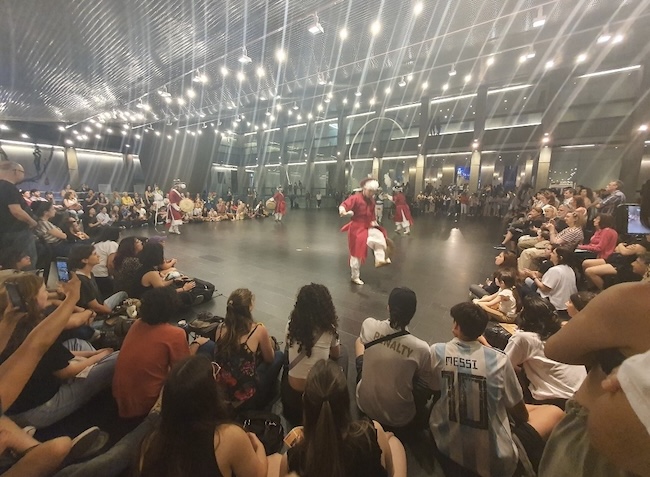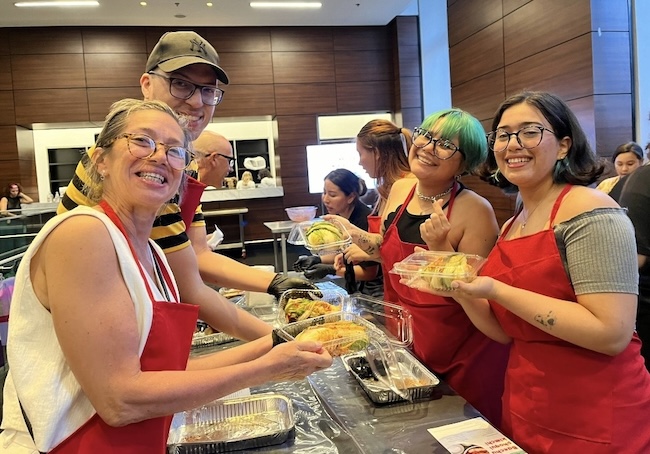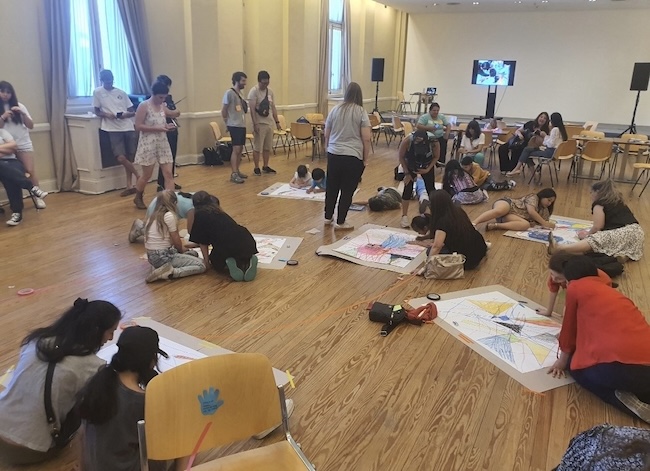
A traditional performance featuring samulnori (traditional percussion) and talchum (mask dance) (Image courtesy of Yonhap)
BUENOS AIRES, Nov. 26 (Korea Bizwire) – At the Libertad Palace (formerly CCK Center), Argentina’s largest multipurpose cultural venue, screens throughout the lobby announce “Korean Culture Month,” highlighting a diverse array of events that showcase South Korea’s cultural heritage.
In a fitting tribute from the first nation to establish Kimchi Day as a national holiday through both houses of parliament, the center hosted multiple Korean cultural events simultaneously on November 23, including kimchi-making workshops, “When Children Meet Art,” and “Body, Body, Body!!! Meeting the World Through Movement,” along with traditional dance performances.
The kimchi-making workshops, scheduled for four weekend sessions, were so oversubscribed that organizers had to turn away eager participants. The sessions began with detailed explanations about kimchi and the benefits of fermented foods, with a notable presence of male participants in aprons.
“Many of the male participants are local restaurant chefs,” a cultural center official noted, adding that professional chefs have shown strong interest in other kimchi-related events as well.
The atmosphere during the lectures was almost solemn as participants concentrated intensely, though their expressions brightened notably when the hands-on preparation began.
Maria, a participant in her 40s who traveled from Mendoza Province with her daughter and aunt, shared her enthusiasm: “Whenever I visit Buenos Aires, I make sure to stock up on kimchi from Korean markets.”
On the center’s sixth floor, young K-pop enthusiasts gathered for “The Moment Children Meet Art,” the first Latin American iteration of a program jointly organized by the Korea Arts & Culture Education Service and the Korean Cultural Center.
Among the participants were sisters Clara, 10, and Vera, 9, whose cultural interests span from K-pop groups to Korean dramas. “I love Korean music and Korean culture so much,” Clara said shyly.
“Our parents told us about this event, so I came with my sister.” While she enjoys all K-pop groups, including BTS and BLACKPINK, she named Stray Kids as her favorite. Both sisters cited “Extraordinary Attorney Woo” as their most memorable Korean drama.
The enthusiasm extends beyond music and television. Mara, 47, who brought her children aged 7 and 12, expressed interest in more Korean language courses: “My child wants to learn Korean in person,” she said, adding that she regretted missing out on the kimchi-making workshop due to its popularity.
Her daughter Julie, 12, mentioned “Strong Woman Kang Nam Soon” and “True Beauty” as recent Korean dramas she had enjoyed.
The children particularly enjoyed creating artwork through a Korean traditional playground game similar to “territory capture,” while teenagers participated in “Body, Body, Body!!!” which included experiencing Korean letters through physical movement.
The day’s highlight was a traditional performance featuring samulnori (traditional percussion) and talchum (mask dance) in the center’s first-floor lobby.
Supported by the National Intangible Heritage Center as part of the “K-Intangible Heritage Festival,” the performance began with a dramatic entrance featuring spinning sangmo (hat with long ribbon) and the dynamic sounds of traditional instruments: kkwaenggwari, buk, jing, and janggu. Audience members raised their phone flashlights in appreciation and responded with enthusiastic cheers.
The crowd learned to chant “Eolssigu jota!” (traditional expression of joy) and responded enthusiastically to the performers. The energy peaked during the mask dance performance, with thunderous applause echoing throughout the venue.
Lina Jang (linajang@koreabizwire.com)







